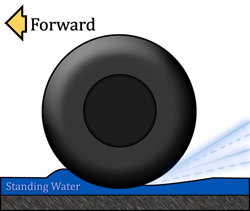
Hydroplaning and Slippery Roads
Hydroplaning causes your vehicle to float on a layer of water. When water in front of your tires builds up faster than your it can be pushed out of the way, tires will hydroplane causing a dangerous lack of friction and possible of control.
A recent government study of more than 11,000 passenger vehicles found that 10 percent of them had at least one bald tire. You can see with new tires that have their full tread. They have a lot of grooves and slots, which provide spaces for water evacuation and biting edges. But when the tires start to lose their tread depth, many of those slots disappear, and you have nowhere for water to go. even with good tires a vehicle can hydroplane at 50 mph. With balding tires it may only take 30 mph to loose contact with the road.
To avoid hydroplaning, make sure you maintain good tread on your tires, keep your tires properly inflated, slow down when roads are wet, and stay away from standing water in the road.
Should your vehicle hydroplane:
Shift to neutral (on a standard transmission, depress the clutch)
One of the most important steps to take if your vehicle hydroplanes is to shift into neutral. This will immediately reduce the amount of power sent to the wheels, allowing them to regain traction on the road more quickly. This also prevents the wheels from locking up, which could cause the vehicle to spin out of control.
When you shift into neutral, you should also avoid braking or turning the steering wheel. Both of these actions can cause the vehicle to skid even more and lead to a loss of control. Instead, you should stay in neutral and focus on steering the vehicle in a straight line until the wheels regain traction
Grip the steering wheel firmly and steer where you want to go
The best way to stay safe if your vehicle hydroplanes is to grip the steering wheel firmly and steer in the direction you want to go. When the tires lose grip, it is easy to panic and make a sudden, jerking motion with the steering wheel. This can cause the vehicle to spin out of control and can even result in an accident. By gripping the steering wheel firmly, you can maintain control of the vehicle and steer in the direction you want to go.
Avoid braking or accelerating
Finally, if you find yourself hydroplaning, it is important to remain calm and avoid braking or accelerating. Rapid acceleration or braking will only cause your vehicle to slide further and increase the chances of an accident. Instead, keep your steering wheel straight and allow your vehicle to slow down gradually.
Check your rear view mirror
The best way to prevent hydroplaning is to make sure you are always driving on properly maintained roads with good traction. You should also make sure you check your rearview mirror regularly to watch for any signs of water on the road. If you see water, slow down and make sure you are far away from any vehicles near you.















